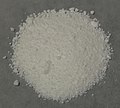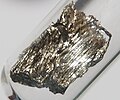Europium(III) hydroxide is an inorganic compound with a chemical formula Eu(OH)3. Europium(III) hydroxide can be prepared by reacting metallic europium...
2 KB (97 words) - 11:02, 20 June 2022
Europium hydroxide may refer to: Europium(II) hydroxide (Europium dihydroxide), Eu(OH)2 Europium(III) hydroxide (Europium trihydroxide), Eu(OH)3 This...
499 bytes (55 words) - 15:19, 25 June 2023
Europium(II) hydroxide is an inorganic compound, with the chemical formula of Eu(OH)2. It can exist as the dihydrate Eu(OH)2·H2O. The monohydrate of europium(II)...
2 KB (192 words) - 01:19, 28 June 2023
atmosphere, slowly turning into the yellow europium(II) hydroxide hydrate and then to white europium(III) hydroxide. EuO crystallizes in a cubic sodium chloride...
6 KB (613 words) - 19:17, 23 July 2024
product. Europium compounds Europium acetate tetrahydrate (Eu(CH3COO)3·4H2O) Europium(III) chloride hexahydrate (EuCl3·6H2O) Europium(III) hydroxide (Eu(OH)3)...
42 KB (4,438 words) - 16:44, 19 February 2024
Americium(III) hydroxide is a radioactive inorganic compound with the chemical formula Am(OH)3. It consists of one americium atom and three hydroxy groups...
6 KB (585 words) - 14:40, 13 September 2023
I L M N and O P R S T U, V, and X Y Z References External links "Cerium (III) Acetate" (PDF). Retrieved 2019-09-28. "Magnesium Sulfite" (PDF). srdata...
84 KB (196 words) - 10:05, 30 October 2024
Samarium(III) hydroxide is an inorganic compound with chemical formula Sm(OH)3. Samarium(III) hydroxide can react with acid and produce samarium salts:...
2 KB (66 words) - 11:28, 3 January 2024
Europium(III) acetate is an inorganic salt of europium and acetic acid with the chemical formula of Eu(CH3COO)3. In this compound, europium exhibits the...
8 KB (804 words) - 05:15, 22 July 2024
EuBr3 Europium(III) chloride – EuCl3 Europium(III) iodate – Eu(IO3)3 Europium(III) iodide – EuI3 Europium(III) nitrate – Eu(NO3)3 Europium(III) oxide...
119 KB (8,735 words) - 18:51, 11 November 2024
Chromium (redirect from Chromium(III))
chromium(III) salts. A tetrahedral coordination of chromium(III) has been reported for the Cr-centered Keggin anion [α-CrW12O40]5–. Chromium(III) hydroxide (Cr(OH)3)...
110 KB (11,965 words) - 20:43, 19 October 2024
gallium ion, [Ga(H 2O) 6]3+ .: 1033 Gallium(III) hydroxide, Ga(OH) 3, may be precipitated from gallium(III) solutions by adding ammonia. Dehydrating Ga(OH)...
74 KB (8,763 words) - 07:25, 17 November 2024
Lanthanide (section Oxides and hydroxides)
lanthanide metals are soft; their hardness increases across the series. Europium stands out, as it has the lowest density in the series at 5.24 g/cm3 and...
107 KB (10,324 words) - 19:20, 14 November 2024
actinide series in the periodic table, located under the lanthanide element europium and was thus named after the Americas by analogy. Americium was first produced...
77 KB (9,332 words) - 09:20, 16 November 2024
silicon and arsenic. Lanthanum reacts slowly with water to form lanthanum(III) hydroxide, La(OH) 3. In dilute sulfuric acid, lanthanum readily forms the aquated...
48 KB (6,048 words) - 10:26, 10 September 2024
fluorescent light. Neodymium(III) acetate can be formed using neutralisation (acetic acid reacts with neodymium oxide, neodymium hydroxide or neodymium carbonate):...
16 KB (1,536 words) - 07:41, 7 April 2024
Lanthanide compounds (section Hydroxides)
in character. All of the lanthanides form hydroxides, Ln(OH)3. With the exception of lutetium(III) hydroxide, which has a cubic structure, they have the...
43 KB (3,229 words) - 04:38, 4 June 2024
with cold water and quite quickly with hot water to form praseodymium(III) hydroxide: 2 Pr (s) + 6 H2O (l) → 2 Pr(OH)3 (aq) + 3 H2 (g) Praseodymium metal...
37 KB (4,830 words) - 15:05, 16 September 2024
with cold water and quite quickly with hot water to form gadolinium(III) hydroxide (Gd(OH)3): 2 Gd + 6 H2O → 2 Gd(OH)3 + 3 H2. Gadolinium metal is attacked...
46 KB (5,729 words) - 00:11, 10 November 2024
Terbium green phosphors are combined with divalent europium blue phosphors and trivalent europium red phosphors to provide trichromatic lighting technology...
44 KB (5,315 words) - 06:46, 11 November 2024
Hydrolysis constant (section Europium)
often applies to cations forming soluble hydroxide or oxide complexes with, in some cases, the formation of hydroxide and oxide precipitates. The hydrolysis...
123 KB (5,187 words) - 01:29, 17 August 2024
Europium hydride is the most common hydride of europium with a chemical formula EuH2. In this compound, europium atom is in the +2 oxidation state and...
4 KB (284 words) - 05:08, 16 July 2024
praseodymium, and minor quantities of samarium, gadolinium, and yttrium. Europium concentrations tend to be low, about 0.05%. South African "rock" monazite...
19 KB (1,970 words) - 18:03, 28 October 2024
261 °F), samarium is the third most volatile lanthanide after ytterbium and europium and comparable in this respect to lead and barium; this helps separation...
72 KB (8,246 words) - 07:26, 16 November 2024
14077–39–5 EuF3 europium(III) fluoride 13765–25–8 EuI2 europium(II) iodide 22015–35–6 EuI3 europium(III) iodide 13759–90–5 EuN europium(III) nitride 12020–58–5...
139 KB (120 words) - 17:07, 15 July 2024
various metals of different valence, including nickel (II), europium (III), americium (III) and thorium (IV), have been conducted. Vercammen et al. (2001)...
21 KB (2,381 words) - 03:42, 5 November 2023
Copper (redirect from Copper(III))
aquo complex. Adding aqueous sodium hydroxide causes the precipitation of light blue solid copper(II) hydroxide. A simplified equation is: Cu2+ + 2 OH−...
122 KB (13,921 words) - 21:34, 13 November 2024
M.; Lee, R. N.; Hayden, K. (1967). "The europium(II) ion reduction of nitrite and nitropenta-amminecobalt(III) ions". Journal of the Chemical Society...
3 KB (314 words) - 04:17, 17 December 2023
The two sources of natural promethium are rare alpha decays of natural europium-151 (producing promethium-147) and spontaneous fission of uranium (various...
41 KB (4,883 words) - 00:06, 31 October 2024
Actinide (section Oxides and hydroxides)
neutralized with hydroxides to pH = 5.8 that results in precipitation of thorium hydroxide (Th(OH)4) contaminated with ~3% of rare-earth hydroxides; the rest...
130 KB (11,599 words) - 02:19, 29 October 2024



















